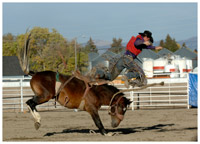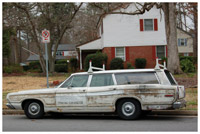Few motorists are aware, but auto industry experts say the station wagon died a quiet death in the 1990s. Mainly due to the growing popularity of the minivan, and later, the sport utility vehicle.
That’s not to say you won’t see any on roadways. Some older models remain, and a new model might surface from year to year. However the days of mass production – and consumption – for the station wagon are over.
Station Wagon Defined
 Most station wagons have bodies that essentially are modified sedans. They are passenger vehicles, but with an expanded rear cargo area, and almost always a rear window that is nearly vertical.
Most station wagons have bodies that essentially are modified sedans. They are passenger vehicles, but with an expanded rear cargo area, and almost always a rear window that is nearly vertical.
That description darn near fits an SUV. The difference is station wagons are cars, while most SUVs are based on a truck platform.
Land Rover’s parent company actually describes some of its models as station wagons.
Station wagons get their name from train travel. Literally they were wagons that carried people and luggage to and from a train station.
Early station wagons did not have glass around the passenger and cargo compartments, and had only bench seats. Station wagons began to become enclosed in the 1920s.
By the end of that decade, Ford was the biggest station wagon seller.
Many early station wagons had wooden bodies, until in the mid-1930s General Motors introduced the Suburban wagon. Soon all steel versions ruled the day.

Recent Wagon Trends
Bucking the trend was the 2008 Volvo V70, a compact wagon that actually enjoyed some success in the American market.
However Volvo has run into some roadblocks due to Partial Zero Emissions Vehicle regulations, and the challenge of meeting those requirements.
Other station wagons have come and gone in recent years. Ford stopped producing its Focus wagon for 2007, and Subaru dropped its Impreza wagon in favor of a five-door hatchback model.
In 2003, Toyota unveiled the Matrix while Pontiac showed off its sister vehicle, the Vibe, but again the companies chose not to continue with production.
Most newer models are compact station wagons. The last full-size wagons were the Buick Roadmaster and Chevrolet Caprice, discontinued in 1995. In 2005, Dodge tried the Magnum, but it is not a true full-sized wagon.
The last subcompact station wagon built in America was the 1992 Toyota Corolla.
Smaller Wagons Don’t Sell Either
Automakers seem to keep tinkering with smaller station wagons, apparently in hope that consumers will appreciate more affordable alternatives to minivans or sport utility vehicles.
Ford, Mercury and Saturn kept domestic wagons in their lineups until around 2004, when they began phasing them our in favor of car-based crossover SUVs and small minivans.
So automakers are still trying to present the station wagon to American motorists – only they’re calling them something else.
From Hollywood to Skid Row
 The station wagon’s heyday was the 1950s to the 1970s. Television shows featured them often – including Mr. Brady’s beast in “The Brady Bunch.”
The station wagon’s heyday was the 1950s to the 1970s. Television shows featured them often – including Mr. Brady’s beast in “The Brady Bunch.”
Smaller two-door versions arrived in the 1970s, including the Ford Pinto and Chevy Vega.
Then a series of events occurred that eventually resulted in the station wagon’s demise
- The 1973 oil embargo resulted in laws that got rid of rear-wheel drive in favor of better fuel efficiency
- American automakers soon thereafter started a trend of going with smaller vehicles
- Fans of larger vehicles during the late 1970s were stuck with sport utility vehicles like the Chevrolet Suburban
- Then Chrysler in 1984 introduced the first minivans, completing the end of the station wagon’s relatively impressive 30-year run.
Will its halcyon days return? Well the record gas prices recently began a slow death for the SUV, and to a lesser extent the minivan.
Stranger things have happened in automotive history. Trends come and go, and it remains to be seen whether the station wagon gets hot again in American culture.
